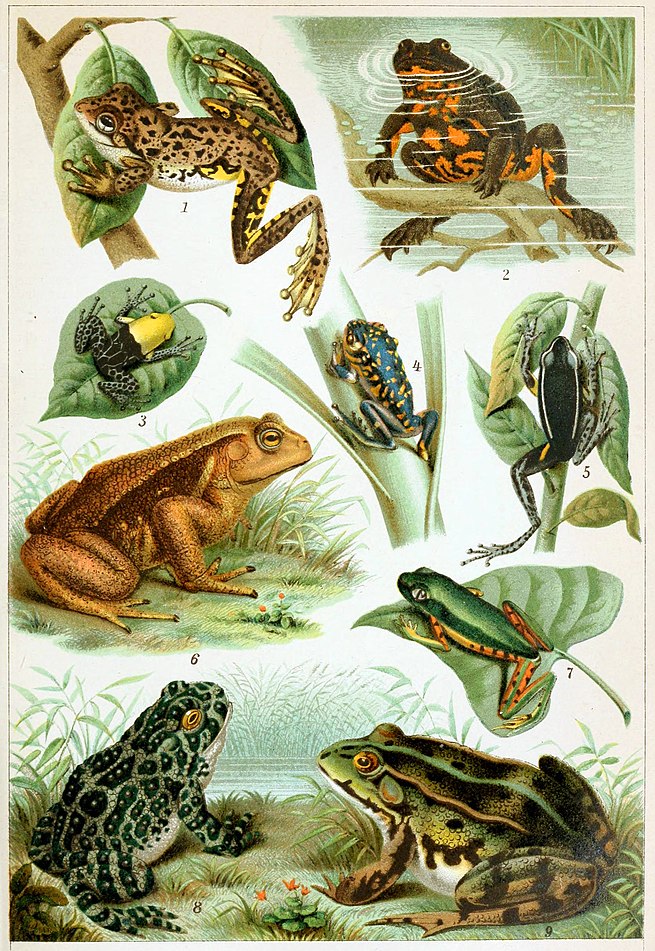
Main Difference
The main difference between Frog and Toad is that the Frog is a order of amphibians and Toad is a amphibian.
-
Frog
A frog is any member of a diverse and largely carnivorous group of short-bodied, tailless amphibians composing the order Anura (Ancient Greek ἀν-, without + οὐρά, tail). The oldest fossil “proto-frog” appeared in the early Triassic of Madagascar, but molecular clock dating suggests their origins may extend further back to the Permian, 265 million years ago. Frogs are widely distributed, ranging from the tropics to subarctic regions, but the greatest concentration of species diversity is in tropical rainforests. There are approximately 4,800 recorded species, accounting for over 85% of extant amphibian species. They are also one of the five most diverse vertebrate orders.
The body plan of an adult frog is generally characterized by a stout body, protruding eyes, cleft tongue, limbs folded underneath, and the absence of a tail. Besides living in fresh water and on dry land, the adults of some species are adapted for living underground or in trees. The skins of frogs are glandular, with secretions ranging from distasteful to toxic. Warty species of frog tend to be called toads but the distinction between frogs and toads is based on informal naming conventions concentrating on the warts rather than taxonomy or evolutionary history. Frogs’ skins vary in colour from well-camouflaged dappled brown, grey and green to vivid patterns of bright red or yellow and black to advertise toxicity and warn off predators.
Frogs typically lay their eggs in water. The eggs hatch into aquatic larvae called tadpoles that have tails and internal gills. They have highly specialized rasping mouth parts suitable for herbivorous, omnivorous or planktivorous diets. The life cycle is completed when they metamorphose into adults. A few species deposit eggs on land or bypass the tadpole stage. Adult frogs generally have a carnivorous diet consisting of small invertebrates, but omnivorous species exist and a few feed on fruit. Frogs are extremely efficient at converting what they eat into body mass. They are an important food source for predators and part of the food web dynamics of many of the world’s ecosystems. The skin is semi-permeable, making them susceptible to dehydration, so they either live in moist places or have special adaptations to deal with dry habitats. Frogs produce a wide range of vocalizations, particularly in their breeding season, and exhibit many different kinds of complex behaviours to attract mates, to fend off predators and to generally survive.
Frogs are valued as food by humans and also have many cultural roles in literature, symbolism and religion. Frog populations have declined significantly since the 1950s. More than one third of species are considered to be threatened with extinction and over one hundred and twenty are believed to have become extinct since the 1980s. The number of malformations among frogs is on the rise and an emerging fungal disease, chytridiomycosis, has spread around the world. Conservation biologists are working to understand the causes of these problems and to resolve them.
-
Toad
Toad is a common name for certain frogs, especially of the family Bufonidae, that are characterized by dry, leathery skin, short legs, and large bumps covering the parotoid glands.A distinction between frogs and toads is not made in scientific taxonomy, but is common in popular culture (folk taxonomy), in which toads are associated with drier skin and more terrestrial habitats.
-
Frog (noun)
A small tailless hops.
-
Frog (noun)
The part of a violin bow (or that of other similar string instruments such as the viola, cello and contrabass) located at the end held by the player, to which the horsehair is attached.
-
Frog (noun)
Road. Shorter, more common form of frog and toad.
-
Frog (noun)
The depression in the upper face of a pressed or handmade clay brick.
-
Frog (noun)
An organ on the bottom of a horse’s hoof that assists in the circulation of blood.
-
Frog (noun)
The part of a railway switch or turnout where the running-rails cross (from the resemblance to the frog in a horse’s hoof).
-
Frog (noun)
A French person.
“baguette”
-
Frog (noun)
A French-speaking person from Quebec.
-
Frog (noun)
A leather or fabric loop used to attach a sword or bayonet, or its scabbard, to a waist or shoulder belt.
-
Frog (noun)
An ornate fastener for clothing consisting of an oblong button (covered with netted thread), toggle, or knot, that fits through a loop.
-
Frog (verb)
To hunt or trap frogs.
-
Frog (verb)
To use a pronged plater to transfer (cells) to another plate.
-
Frog (verb)
To spatchcock (a chicken).
-
Frog (verb)
To ornament or fasten a coat, etc. with frogs.
-
Frog (verb)
To unravel (a knitted garment).
-
Toad (noun)
An amphibian similar to a frog with shorter hindlegs and a drier, more ragged skin.
-
Toad (noun)
A contemptible or unpleasant person.
-
Toad (verb)
To expel (a user) permanently from a MUD or similar system, so that their account is deleted.
